John Robert Baylor and Josephus & Frank Browning |
|
John Robert Baylor
The following article is by Bill Fairley and was published in the Fort Worth Star Telegram, Wed, Aug. 18, 2004.
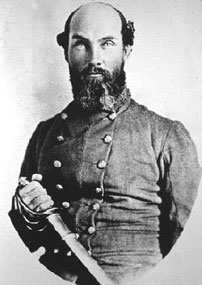
Photo Courtesy of the Texas Collection/Baylor University
John Robert Baylor, kin to several famous Baylors, had a life marked by conflict during the 19th century in Texas and the Indian Territories. Military man, rancher found his way into many fights
The life of former Weatherford resident John Robert Baylor was stormy and bloody, even for the North Texas frontier.
Baylor was a lawyer and a politician. He also worked for a while as an Indian agent but was fired, and later he aggressively hunted Indians, not to make treaties but to kill them.
Baylor was a slave owner who readily joined the Confederate army. That gave him the opportunity to fight not only Union soldiers but also Indians. And he made himself the Confederate governor of the Arizona Territory.
More peacefully, he was a rancher and father of 10 who lived to the age of 72.
Don't confuse John Robert Baylor with George W. Baylor, who is in the Texas Rangers Hall of Fame. That was his brother. And don't assume that Baylor County was named for him. No, that was another brother, Henry Weidner Baylor. Nor is Baylor University his namesake. The school, the first one chartered by the Republic of Texas, was named for an uncle, Robert E.B. Baylor.
John Robert Baylor was born in 1822 in Paris, KY. to Dr. John Walker Baylor, an Army surgeon, and Sophie Marie Weidner Baylor. After his father's death, he was sent to live with his uncle near Rocky Creek in Fayette County, Texas.
In 1840, when he was 18, Baylor joined a Texas volunteer army commanded by Col. John H. Moore. In late 1842, he moved to Fort Gibson in Indian Territory (now Oklahoma) to teach school at the Creek Indian Agency. The next year, he was with his brother-in-law, James Dawson, when Dawson killed an Indian trader, Seaborn Hill. Charged as an accomplice, Baylor escaped across the Red River into Texas.
In 1844, he married Emily Hanna in Marshall. They had seven sons and three daughters.
Baylor began farming at Ross Prairie in Fayette County. In 1851, he was elected to the state Legislature, and two years later, he became an attorney and was admitted to the Texas Bar.
In September 1855, Baylor was appointed Indian agent to the Comanches on a reservation on the Brazos River. Two years later, he was fired, in part because of a feud with his boss and in part because he accused the Comanches of helping Indians who didn't live on the reservation in raids on white settlers.
Something had happened to turn Baylor into a fierce Indian-hater. He traveled throughout North Texas, stirring up fear of the Comanches and Kiowas. He organized a vigilante force and edited an anti-Indian newspaper called White Man, published first in Jacksboro and later in Weatherford where he and his family had made their home.
When Texas seceded from the Union, Lt. Col. Baylor was put in command of the Second Texas Mounted Rifles, which was assigned to occupy forts protecting stagecoach routes between Fort Clark and Fort Bliss at El Paso. From Fort Bliss, Baylor prepared to occupy the Mesilla Valley in the Arizona Territory. (Mesilla was south of present-day Las Cruces, N.M.)
On Feb. 14, 1862, Confederate President Jefferson Davis issued a proclamation to "organize the Territory of Arizona to be in full force and operation ... I have proceeded to appoint officers ... in and for said Territory."
One of these officers was Baylor.
At Mesilla, Baylor, now a full colonel, established the Confederate Territory of Arizona and proclaimed himself military governor. The territory included what is now New Mexico and Arizona south of the 34th parallel.
After Robert P. Kelly, editor of the pro-Confederate Mesilla Times, wrote unflattering articles about him, Baylor fatally injured Kelly in a fight.
Indian raids continued in the territory as troops concentrated more on the Civil War than on protecting settlers. At one point, Baylor sent a letter to a Confederate captain guarding the Pinos Altos mines ordering him to "exterminate" hostile Apaches. When Davis learned of the order, he relieved Baylor of civil and military commands.
Returning to Texas, an undaunted Baylor fought as a private at the battle of Galveston on Jan. 1, 1863. He even ran for the Second Confederate Congress, defeating Malcolm D. Graham.
Baylor moved to San Antonio, where he opposed Richard Coke for the Democratic nomination for governor in 1873.
In 1876, at 54, he moved to Montell on the Nueces River northwest of Uvalde and bought a ranch. He is reported to have killed a man in 1880 in a dispute over livestock. However, he was not charged with the crime.
He died Feb. 6, 1894, at age 72 and is buried in Montell's Ascension Episcopal Cemetery.
Source: the Handbook of Texas Online and Colonel John Robert Baylor by Jerry Don Thompson, Hill Junior College Press, 1971.
Josephus and Frank Browning
The Browning Ranch on Hubbard Creek, not a great distance from its
mouth, was a well known place during the pioneer days. This ranch
was near the present town of Crystal Falls, in Stephens County. During
the middle of June 1860, Josephus and Frank Browning, sons of William
Browning, were out riding the range in search of cattle. When the
noon hour arrived, these boys were below the mouth of Hubbard's creek
and about one mile from the Clear Fork, in a mesquite and live oak
flat. Since it was extremely hot weather, they decided to stop under
the shade of a tree and let their horses graze. A short time later,
they heard Indians coming. So the Browning boys hurriedly cut the
hobbles from their ponies and started away. Since Josephus had more
difficulty with his horse, he was soon overtaken by Indians and killed.
Frank being badly wounded, fell from his saddle when he crossed Hubbard's
Creek. Frank's pony, with two arrows sticking in his body, ran to
the ranch. Wm. Browning instantly knew Indians had attacked his sons.
So he, in company with others, took the back trail of the pony. When
Frank was found at a crossing of Hubbard's Creek about one and a half
miles east of the present town of Crystal Falls, was still conscious
and able to relate the story to this father. Frank stated, "I
stayed with Joe until he was killed, then I ran away from the Indians."
He also told his father the feathered warriors attempted to grab his
bridle reins. But when he shot two or three of their number, the Indians
fell back. William Browning then sent to the ranch for a wagon, and
after Frank was carried home, the relief party brought in the body
of Josephus. Frank was wounded about seventeen different times and
at least two or three arrows passed completely through his body. But
under the care and treatment of a doctor summoned from Fort Belknap,
he recovered. His death, however, about twenty years later, largely
attributed to the old wounds.
The living witnesses interviewed by the author slightly differ concerning
what the boys were doing at the moment the Indians charged. But we
sincerely believe this one of the most accurate accounts of this Indian
killing that has ever been written.
Before writing this story, the author went to Oklahoma to personally
interview J.S. Schoolcraft, whose sister married Frank Browning;
also went to San Antonio to interview Walker Baylor, who saw the corpse
of Josephus Browning and whose brought back nine of the scalps of
the particular Indians who murdered Josephus. Also interviewed J.R. Browning, a cousin, F.M. Peveler, J.V. Mathews, James Clark,
and others who were living in Stephens and adjoining counties, when
Josephus Browning was killed.
The above story is from the book, The West Texas Frontier, by
Joseph Carroll McConnell.
J.W. Wilbarger describes the Browning boys' encounter in his book, Indian Depredations in Texas, which appears below:
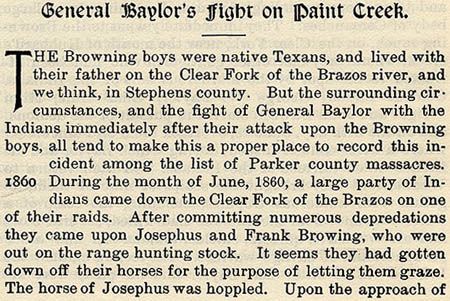
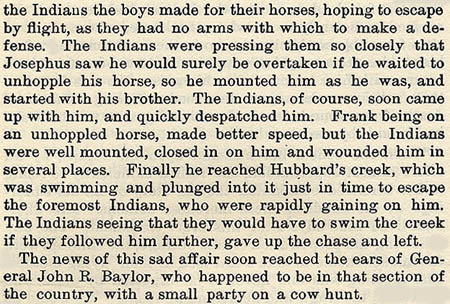
The picture and text below are from the book, A Cry Unheard,
by Doyle Marshall.
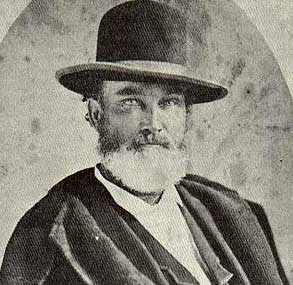
John Robert Baylor (above) and his brother, Walker, gathered a posse
and swore to revenge the murders. They killed twelve Indians marking
the first success the local men had against the Indians.
On about June 11, 1860, while John R. Baylor, his twenty-five year-old
brother, George, his fourteen year-old son, Jack, and other cowmen
of the vicinity were rounding up the Baylor cattle, a messenger brought
the sad news that Indians had killed and scalped Josephus Browning
and had shot Frank Browning so full of arrows that it appeared he
could not live.
...Miraculously, Frank later recovered from his wounds and lived
many years to tell about the tragic experience.
...Looking down at the cold body of Josephus, George Wythe Baylor
emotionally recalled his friendship with the young victim and vowed
that the murderers would pay for their crime. Upon leaving the Browning
home, John Baylor grasped the hand of "Uncle Billy" and
assured him that, if possible, the death of his noble son would be
avenged by the taking of Indian scalps.
At the Browning home a party was formed to pursue the guilty band.
As usual, the elder Baylor was selected to lead the vindictive ranchers.
Marker Title: General John R. Baylor
Address: US 55
City: Montell
County: Uvalde
Year Marker Erected: 1963
Marker Location: US 55 just inside Montell limits (past churches), Montell.
Marker Text: Born in Kentucky. Came to Texas Republic 1839. Colorful
Indian fighter. In war against Cherokees 1840. Member Texas Legislature
1853. Comanche agent 1855-57. Delegate from Weatherford, Secession Convention.
Commanding detachment of Second Regiment Texas Mounted Rifles occupied,
took over supplies, Ft. Bliss. June 1861-- during campaign to extend
Confederacy westward to the Pacific. Repulsed Federals, Mesilla, N.
Mex., July 25. With 200 men took 700 Federals, their transports, arms,
ammunition, 200 horses, 270 beeves, four cannon at San Augustin Springs,
July 27. With Capitol at Mesilla, organized government, proclaimed Confederate
control of Arizona, Aug. 1. Baylor became military, civil governor.
Sent C.S.A. Treasury $9,500 captured at Ft. Fillmore. Supervised gold,
silver mining for C.S.A. Order to kill instead of capture troublesome
Apaches incensed authorities against him, had Baylor recalled to Texas,
stripped of rank. As private "served guns in hottest of the fight"
to recapture Galveston, Jan. 1, 1863. Salvaged U.S. warship parts to
make cannon light enough to go into battle on back of mule. 1863-63
in Confederate Congress. Given new command. Made Brigadier-General 1865.
Raised, led troops in frontier defense. Fear of his moves pinned down
thousands of Federals in California, Arizona. Climaxed war service on
Northwest Texas border. Post-war lived in San Antonio. Farmed, ranched
Uvalde County. Buried in Montell. Erected by the state of Texas 1963.
In the book, Blood & Treasure, Donald S. Frazier gives a further description of the 6' 3", 230 lb., blue-eyed John R. Baylor.

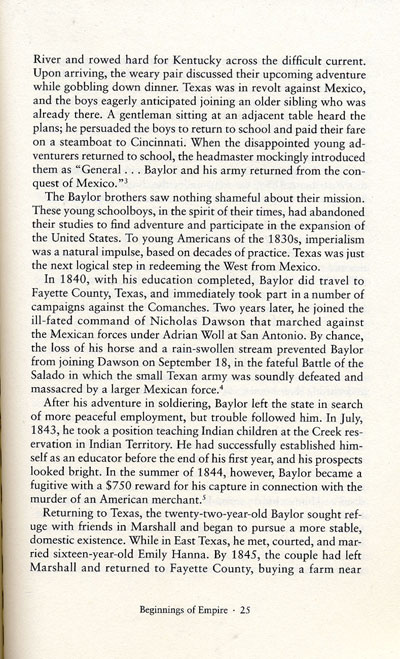
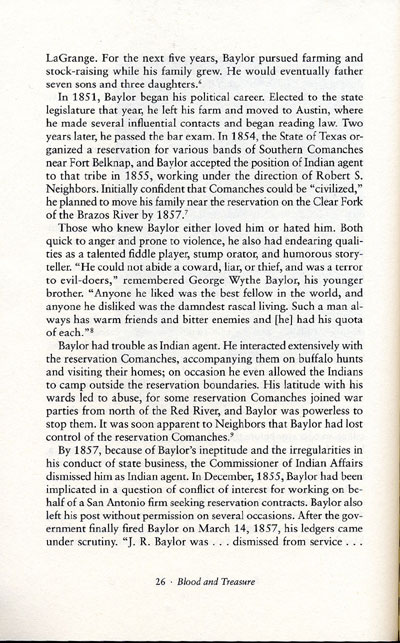
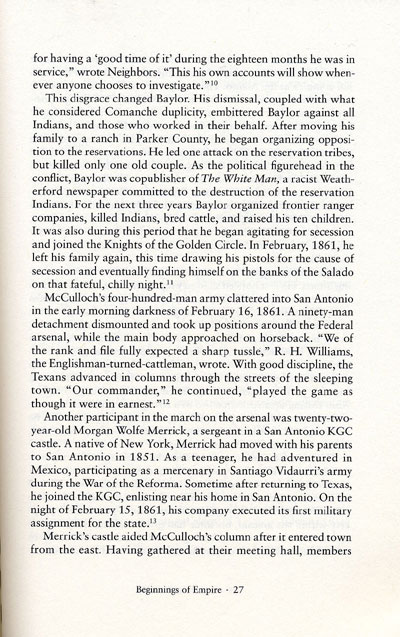
The following is from the book, Lambshead Before Interwoven, by Frances Mayhugh Holden.
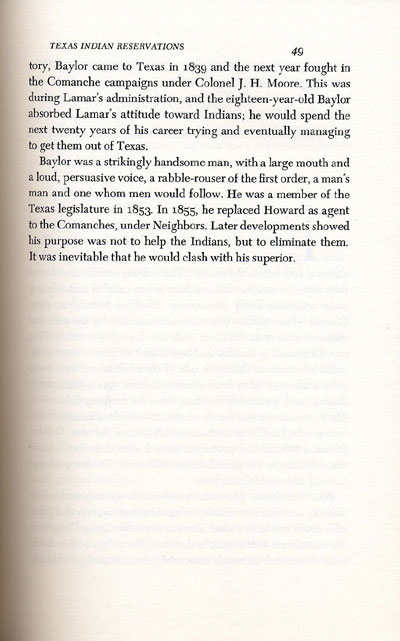
The Demise of Baylor's Associates 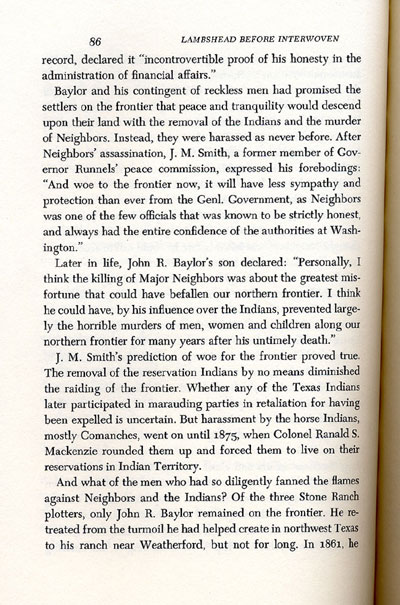
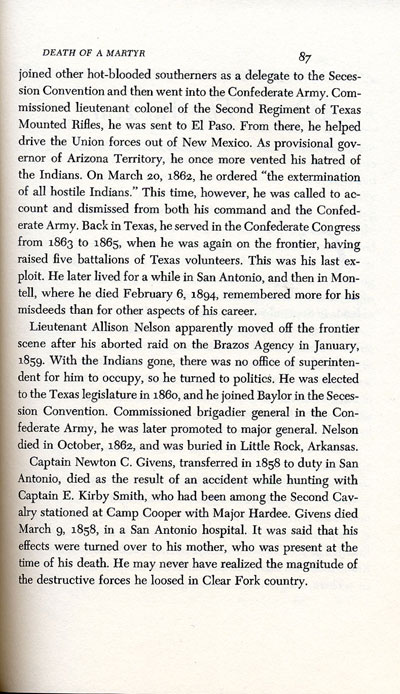
|